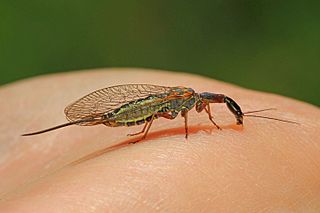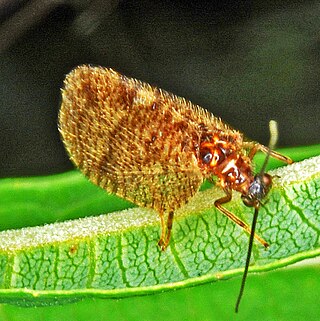
Snakeflies are a group of predatory insects comprising the order Raphidioptera with two extant families: Raphidiidae and Inocelliidae, consisting of roughly 260 species. In the past, the group had a much wider distribution than it does now; snakeflies are found in temperate regions worldwide but are absent from the tropics and the Southern Hemisphere. Recognisable representatives of the group first appeared during the Early Jurassic. They are a relict group, having reached their apex of diversity during the Cretaceous before undergoing substantial decline.

Inocelliidae is a small family of snakeflies containing 8 genera of which one is known only from fossils. They are commonly known as inocelliid snakeflies. The largest known species is Fibla carpenteri known from fossils found in baltic amber.

Nanoraphidia is an extinct genus of snakefly in the family Mesoraphidiidae containing the species Nanoraphidia electroburmica and Nanoraphidia lithographica.
Electrinocellia is an extinct monotypic genus of snakefly in the family Inocelliidae containing the single species Electrinocellia peculiaris and known from Eocene aged Baltic amber.

Florissantoraphidia is an extinct genus of snakefly in the family Raphidiidae containing two described species Florissantoraphidia funerata and Florissantoraphidia mortua. Both species were originally placed in the living raphidiid genus Raphidia, as Raphidia funerata and Raphidia mortua respectively. before being redescribed and transferred to the newly erected genus in 2014.

Styporaphidia is a genus of snakefly, belonging to the extinct family Mesoraphidiidae, containing up to three species, the type species Styporaphidia magia, Styporaphidia willmanni and tentatively Styporaphidia? hispanica. The genus was named from the Greek stypos meaning "stem" or "stump" and Raphidia, the type genus for, and most often used as, a stem for generic names in the order Raphidioptera. The species name of S. magia is from the Greek word mageia meaning "magic" while the species name for S.? hispanica is from the Latin Hispania meaning "Spain" in reference to the type locality of the species.

Archiinocellia is an extinct genus of snakefly in the family Raphidiidae known from Eocene fossils found in western North America. The genus contains two species, the older Archiinocellia oligoneura and the younger Archiinocellia protomaculata. The type species is of Ypresian age and from the Horsefly Shales of British Columbia, while the younger species from the Lutetian Green River Formation in Colorado. Archiinocellia protomaculata was first described as Agulla protomaculata, and later moved to Archiinocellia.

Agulla is a genus of modern snakeflies in the family Raphidiidae.
Agulla mineralensis is an extinct species of snakefly in the raphidiid genus Agulla. The species is solely known from the Middle Miocene, late Bartovian stage, Pacific Union Site in the Stewart Valley Group, Mineral County, Nevada.

Amarantoraphidia is an extinct genus of snakefly in the family Mesoraphidiidae. The genus is solely known from Early Cretaceous, Albian age, fossil amber found in Spain. Currently the genus comprises only a single species Amarantoraphidia ventolina.

Cantabroraphidia is an extinct genus of snakefly in the family Mesoraphidiidae. The genus is solely known from fossil amber found in Cantabria, northern Spain, dating to the Albian age of the Early Cretaceous Period. Currently the genus comprises a single species Cantabroraphidia marcanoi.

Mesoraphidiidae is an extinct family of snakeflies in the suborder Raphidiomorpha. The family lived from the Late Jurassic through the Late Cretaceous and is known from twenty-five genera. Mesoraphidiids have been found as both compression fossils and as inclusions in amber. The family was first proposed in 1925 by the Russian paleoentomologist Andrey Vasilyevich Martynov based on Upper Jurassic fossils recovered in Kazakhstan. The family was expanded in 2002 by the synonymizing of several other proposed snakefly families. The family was divided into three subfamilies and one tribe in a 2011 paper, further clarifying the relationships of the included genera.
Lebanoraphidia is an extinct genus of snakefly in the family Mesoraphidiidae. The genus is solely known from Cretaceous, Upper Neocomian, fossil amber found in Lebanon. Currently the genus is composed of a single species Lebanoraphidia nana.
Iberoraphidia is an extinct genus of snakefly in the family Mesoraphidiidae. The genus is solely known from a Cretaceous, Lower Barremian, fossil found in Spain. Currently the genus is composed of a single species, Iberoraphidia dividua.

Raphidiidae is a family of snakeflies in the order Raphidioptera.
This list of fossil arthropods described in 2011 is a list of new taxa of trilobites, fossil insects, crustaceans, arachnids and other fossil arthropods of every kind that have been described during the year 2011. The list only includes taxa at the level of genus or species.
Negha meridionalis is a species of square-headed snakefly in the family Inocelliidae. It is found in North America.

Negha is a genus of square-headed snakeflies in the family Inocelliidae. There are at least three described species in Negha.

Megalomus hirtus, common name bordered brown lacewing, is a species of brown lacewings in the family Hemerobiidae.

Megalomus tortricoides is a species of brown lacewing in the family Hemerobiidae. It was first described by Rambur in 1842.















